Laptop Mag Verdict
The second-generation Razer Blade crams a new Core i7 CPU and high-powered Nvidia graphics into a slim chassis with a one-of-a-kind gaming touchpad.
Pros
- +
Elegant and slim design
- +
Extremely portable
- +
Impressive overall performance
- +
Secondary screen and Switchblade UI can help gamers
Cons
- -
Expensive
- -
Runs hot on bottom during gameplay
- -
Not as fast as bulkier rigs
Why you can trust Laptop Mag
Razer has created a beautiful monster. Last year the company released its first ever gaming notebook with a unique secondary LCD screen that does double duty as an in-game dashboard and gaming trackpad. The $2,499 second-gen Razer Blade retains the slim, sexy profile of its predecessor, while bumping up the speed. Improved specs include a newly-released Intel Core i7 processor and Nvidia GTX graphics. But does this Blade have what it takes to slice and dice the competition?
Design
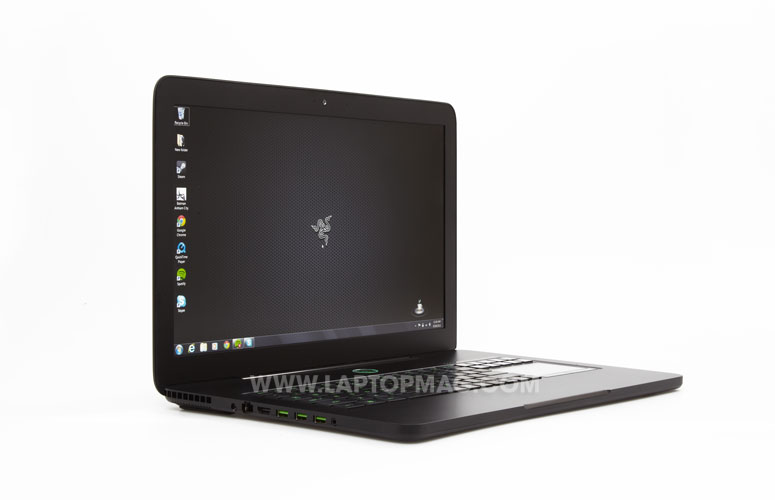
Click to EnlargeWith the Blade, Razer answers the question of what a cross between a 17-inch Macbook Pro and an Alienware M17x might look like. It combines the thinness of the former with the subtle menace of the latter. The Blade's matte black aluminum lid has two small ridges that reminded us of the hood of a late 60s muscle car. Our eyes were drawn to Razer's green three-headed snake insignia that glows seductively, urging us to caress the cool lid. Doing so, however, immediately left a plethora of fingerprints and smudges.
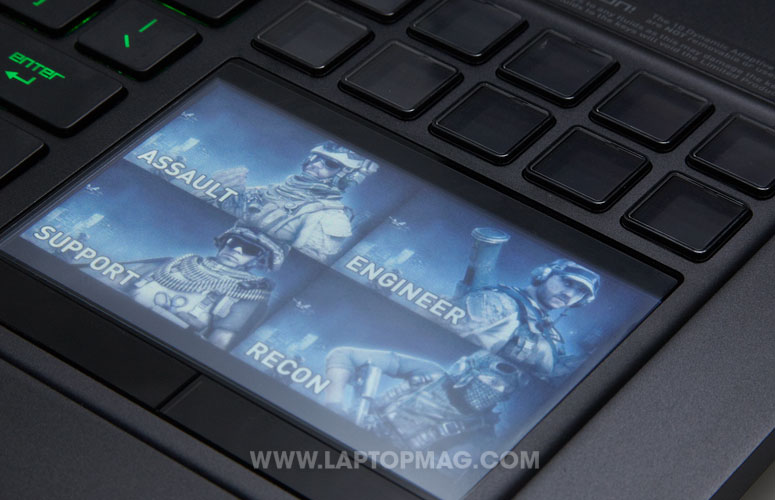
Click to EnlargeUpon opening the notebook, you'll see the biggest difference between the Razer laptops and every other notebook on the market. The touchpad -- which is now an LCD panel -- sits on the right side of the keyboard, and directly above it are two rows of LED-backlit macro buttons.
Above the keyboard is a large pulsating power button, and above that, just below the screen, is a thin speaker grille. Like the lid, the notebook's interior is also made of black aluminum, which makes the emerald green backlit keyboard and power button pop.
The underside of the notebook also has a hint of dramatic flair, thanks to the diamond-cut heating vents.
At 6.6 pounds and 0.88 inches thick, the Razer Blade is by far the lightest and thinnest gaming notebook on the market. It's slightly lighter than the 15-inch 15.4 x 10.4 x 1-inch Macbook Pro which weighs 6.8 pounds. The 16.1 x 11.9 x 1.75-inch Alienware M17x R4, by comparison, tips the scales at 9.8 pounds and is twice as thick. The 16.2 x 10.9 x 1.7-1.8-inch Origin Eon 17S and the 16.3 x 12.6 x 0.9-2-inch Samsung Series 7 Gamer weigh 8.2 and 8.4 pounds respectively.
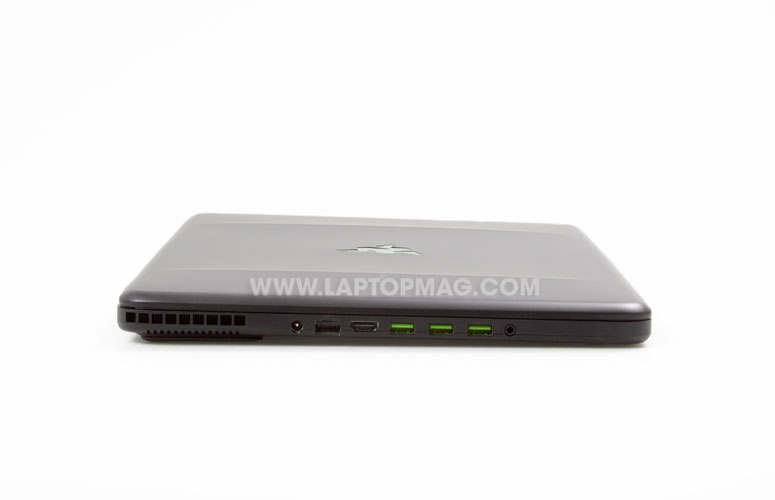
Click to EnlargeWe easily slid the Blade into a large messenger bag and went about our merry way. Despite being stuck in a standing-room only subway car for over an hour, we didn't experience any immediate shoulder or back pain. Compare that to the hefty M17x, that has to be stuffed into a large backpack and causes almost immediate aches and pains.
The Blade's power brick is also a marvel of design.The diminutive 5.75 x 2.25 x 0.6-inch brick weighs 10.6 ounces but still manages to deliver the necessary 120W of power. The 18.4-inch Alienware M18x R2's power brick weighs a whopping 2.4 pounds. Razer even managed to spice up the brick by adding its insignia on the front.
Display
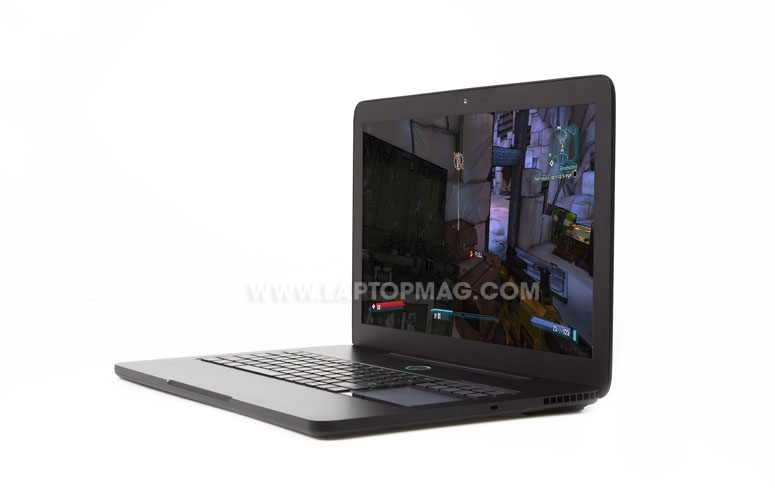
Click to EnlargeMatte or glossy? It's the perennial question concerning displays. Razer outfitted the Blade with a matte 17.3-inch, full HD display (1920 x 1080p), which provides sharp images and wide viewing angles.
Borderlands 2's cel-shaded graphics were breathtaking on the Blade. The frozen wastelands of the opening stage was at once beautiful and terrifying. The gray overcast sky added to the abject loneliness of a world populated by stark white ice crags and shaggy gray beasts with fur mottled red from their last kill.
However, when compared side by side, the Alienware M17x R4's display delivered a more vivid vista. This was most evident when day turned to night and an undulating Aurora Borealis danced above our heads.
When we watched the 1080p trailer of "The Master," Joaquin Phoenix's skin tone looked more lifelike on the M17x, but the Razer Blade displayed the tiniest imperfections in the actor's skin.
The Blade's 256 lux display is slightly higher than the 250 lux desktop replacement average. However, it's a little dim compared to the Eon 17S, M17x and Series 7 Gamer which scored 262, 282 and 325 lux, respectively.
Audio
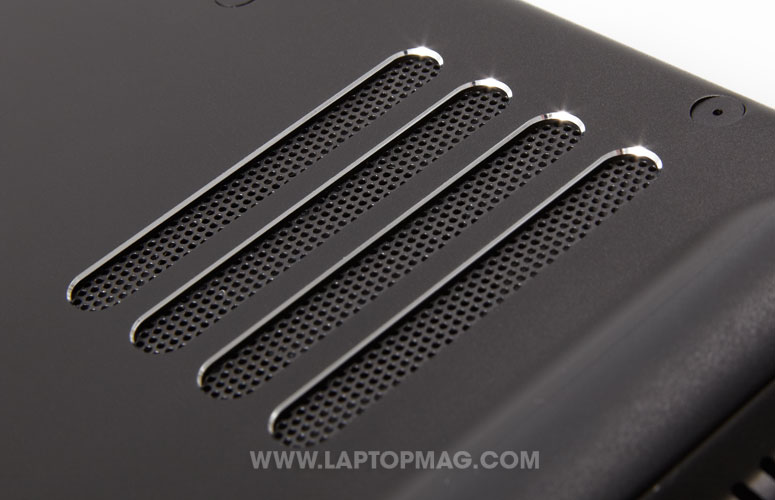
Click to EnlargeDespite its unassuming thin speaker strip, the Razer Blade delivers big, rich sound. As we played Borderlands 2, we could hear the muffled crunch of our footsteps on a snow-covered glacier. The deep booming roar of the Bullymong accented the jarring boom of our shotgun.
When we listened to Wale's "Lotus Flower Bomb," the organs sounded right at the edge of distortion at maximum volume. The rapper's raspy delivery was a perfect counterbalance to the sultry hook sung by Miguel.
Keyboard
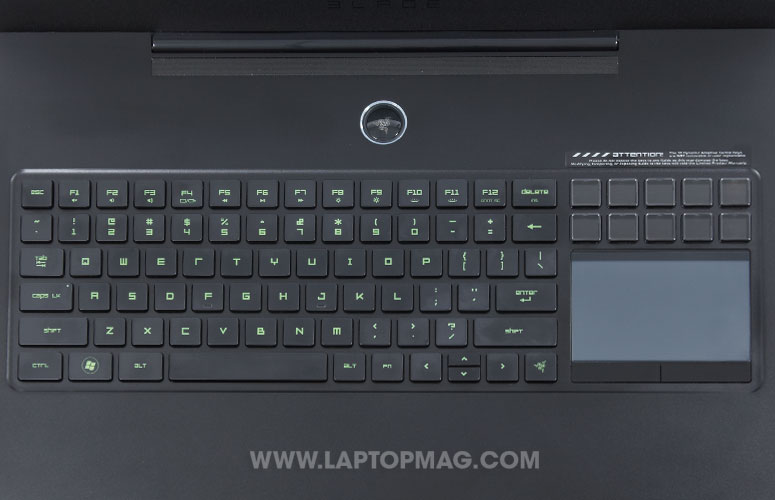
Click to EnlargeThe Blade's island-style keyboard is lovely to behold. The block-style lettering glows green against the black matte keys, and made us feel like we were deciphering some new language. The keys have generous spacing, but in order to make room for the touchpad, the backspace and enter keys are smaller than we would like. The space bar is also slightly undersized. Similar to the rest of the chassis, the keyboard is susceptible to fingerprints.
As we typed, the keys delivered nice springy feedback. We scored 47 words per minute on the Ten Thumbs Typing Test with a 1 percent error rate. That's slightly higher than our normal 45 wpm/1 percent error rate.
One of the keyboard's best features is that it's completely customizable. That means you can record macros and map them to any button on the keyboard, a big plus for gamers that like to create custom controls. A special button emblazoned with the company logo works in tandem with the special features of the touchpad.
Touchpad
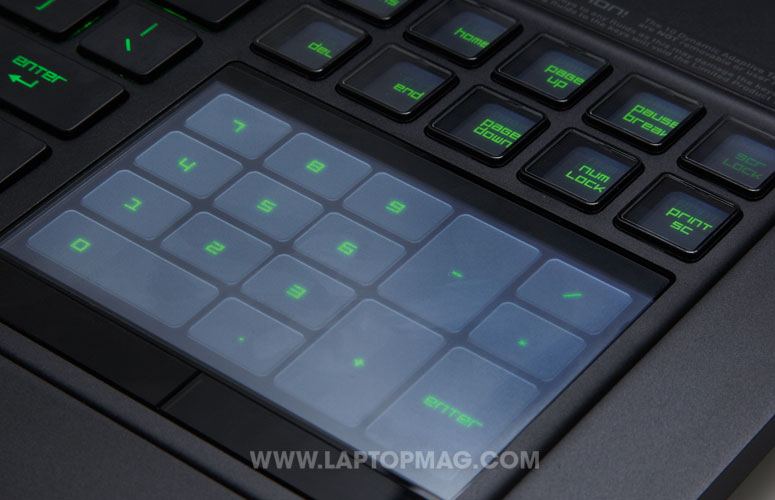
Click to EnlargeRazer's 3.5 x 2.3-inch Synaptics touchpad/track panel is anything but traditional. Instead of its usual position under the keyboard, the touchpad sits to the right. This takes some getting used to. We constantly found ourselves sweeping our fingers below the keyboard, searching for a phantom touchpad.
The LCD multitouch track panel performed well with precise navigation on websites and documents. Highlighting text was also seamless. Multitouch gestures including pinch-to-zoom, two-finger scroll, three-finger press and flick were smooth as well.
The glossy black plastic discrete mouse buttons are a little on the thin side, but they delivered firm feedback during our use.
Switchblade Interface
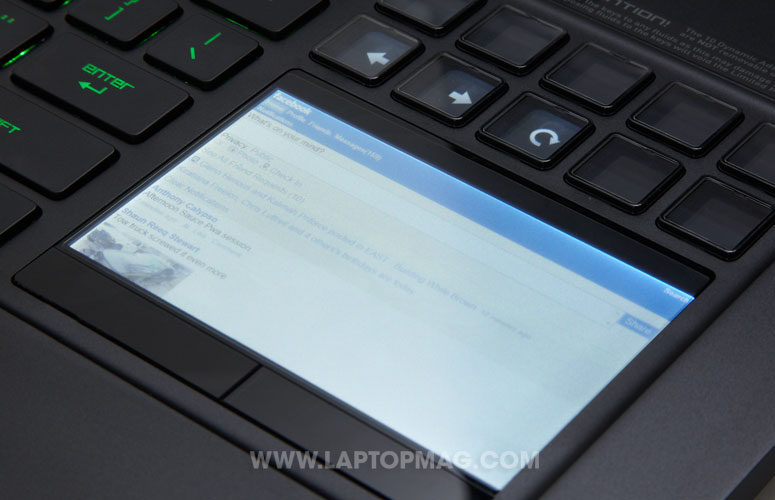
Click to EnlargeIn addition to serving as a touchpad, the LCD track panel acts as a second display. In conjunction with the 10 Dynamic Adaptive Tactile Keys, the panel can also be used to activate shortcuts and macros in games via Razer's Switchblade user interface.
When we first activated the Switchblade interface (we had to create a free Razer account), the keys were illuminated with bright colorful icons for a screenshot button, game timer, Gmail, Twitter, Facebook, and a Web browser, among others. Pressing the Facebook button, for instance, brought up the mobile version of Facebook on the touchpad, where we could log into our account.
Users can also create up to 10 pages of personal shortcuts with their own custom icons. You can switch between pages by performing a three-finger swipe on the touch pad. Returning to the home page is a simple as pressing the Razer button next to the touchpad.
Launching the web browser, YouTube and other social networking buttons instantly transforms the track panel into a 800 x 480-pixel display, complete with touchscreen capabilities such as pinch-to-zoom and scroll. However, text on the smaller display is difficult to read without zooming in, and once we did zoom in, text was riddled with jagged edges.
However, we appreciated the ability to launch applications on the screen without exiting our games on the main screen. During our time with the Blade, we used the YouTube app to find video of a particular challenge in Borderlands 2. We also used the Snapshot button to capture some of our more gloat-worthy moments.
Synapse 2.0 Software
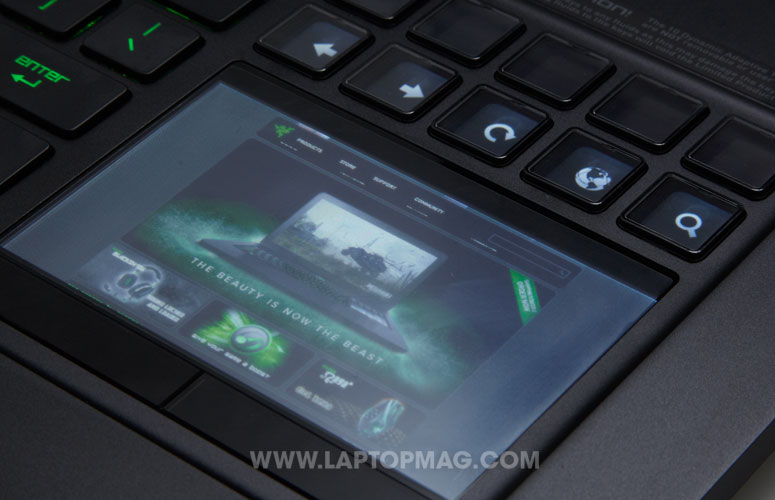
Click to EnlargeThe LCD touch panel and its accompanying buttons are nice, but they're nothing without Razer's Synapse 2.0 software. Acting as the brains of the touch panel, Synapse 2.0 enables users to customize settings such as mouse sensitivity and keyboard and display brightness. Users can also create profiles for the keyboard, including custom macros and icons for the 10 Dynamic Adaptive Tactile Keys.
Razer included groups of macros for Team Fortress 2, Battlefield 3, Star Wars: The Old Republic and Counter Strike: Global Offense. Used in tandem with the titles, these game profiles streamline certain functions, shaving seconds off your reaction time. For example, the Battlefield 3 macros let you quickly switch between weapons and fast access to equipment. The Team Fortress 2 macros support every character class, mapping their abilities to the 10 buttons.
We also created a Borderlands 2 custom profile. We started by tricking the touchpad out with some cool Borderlands 2 wallpaper. From there we created a custom icon using more promotion art. We then recorded our custom macros and mapped them to our preferred buttons, linking them to the profile. The process is fairly straightforward, but mapping macros can become a deeply involved project depending on the level of customization.
On the plus side, Razer stores your profiles in the cloud, eliminating the need to recreate them every time you use a new notebook or mouse. Razer also says that customers will be able to share profiles they create for the Switchblade UI with other Blade owners, much the same way that owners of its gaming mice can share profiles with others.
Heat
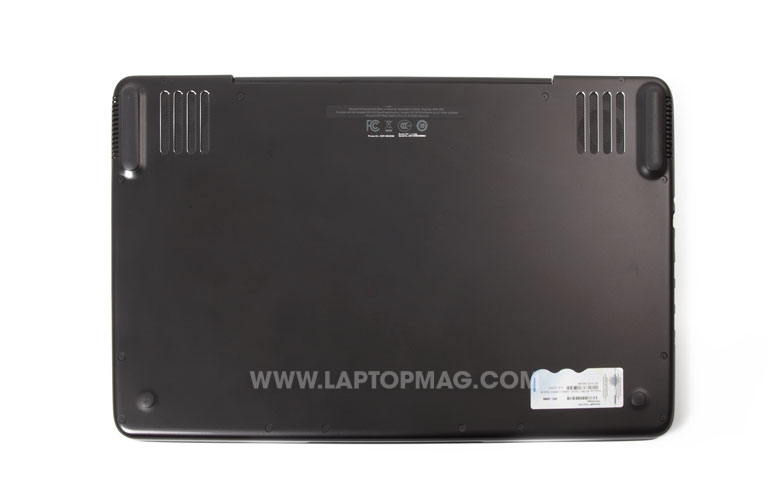
Click to EnlargeAfter watching an episode of Desert Punk, the touchpad measured 80 degrees Fahrenheit. The space between the G and H keys registered 88 degrees and the underside measured 90 degrees.
Things heated up as we played Batman: Arkham City. The touchpad measured 86 degrees, and the space between the G and H keys rose to 99 degrees. We consider anything above 95 uncomfortable, so were disappointed that the underside soared to 108 degrees when playing this title.
Webcam
Although the Blade comes with a 2-megapixel webcam, Razer neglected to include any accompanying software. Nevertheless, when we took a test shot using Skype, we saw a pleasing and rich warmth in our skin tone. In addition, details were fairly sharp; we could see a few flyaway hairs in the shot.
Ports
The Blade is relatively light on ports. A lone secure lock slot sits on the notebook's right. The left side houses a trio of USB 3.0 ports, HDMI, Gigabit Ethernet and jacks for headphones and the AC adapter. Frustratingly, Razer did not inlcude an SD Card slot.
Gaming and Graphics
Click to EnlargeRazer has literally stepped up its game, upgrading the Razer Blade to an Nvidia GeForce GTX 660M GPU with 2GB of VRAM over GT-level graphics on the original notebook. Thanks to Nvidia's Optimus technology, the notebook switches between its discrete and integrated Intel HD Graphics 4000 GPU depending on the task at hand. Still, this svelte rig had a hard time competing with some of the bigger gaming systems on the market.
On the 3DMark11 benchmark, the Blade scored 2,623. That's 602 points less than the 3,238 desktop replacement average. By comparison, the $1,899 Samsung Series 7 Gamer (2.3-GHz Intel Core i7-3610QM, 16GB RAM, Nvidia GeForce GTX 675M/2GB VRAM) scored 3,651.
Other rigs with beefier specs also posted higher scores. The Origin Eon 17S ($3,370; 2.9-GHz Intel Core i7-3920XM CPU, 16GB RAM, Nvidia GeForce GTX 675M/2GB VRAM) scored 3,502. The Alienware M17x R4 ($2,599; 2.6-GHz Intel Core i7-3720QM, 8GB RAM, Nvidia GTX 680M GPU) posted a scorching 6,158.
The Blade averaged 104 fps in World of Warcraft at native resolution (1920 x 1080), with graphics on autodetect. That's fast but 80 frames behind the 184 fps category average. The Series 7 Gamer scored 167 fps while the Eon 17S delivered 232 fps. The M17x R4 posted 279 fps, blowing the competition away. When we cranked it up to maximum, the Blade notched 51 fps, falling short of the 97 fps category average. The Eon 17S scored 129 fps followed by the Series 7 Gamer at 135 fps. The M17x R4 delivered a whopping 147 fps.
Click to EnlargeOn the more graphically taxing Batman Arkham: Asylum, the Razer Blade notched 38 fps at 1920 x 1080. That's playable, but it's much less than the 71 fps desktop replacement category average. The Series 7 Gamer and the Eon 17S did better with 65 and 69 fps, respectively. The M17x R4 came out on top with an impressive 82 fps.
At maximum settings, the Blade dropped to an unplayable 24 fps, failing to match the 38 fps average. The M17x R4 continued to shine with 52 fps, while the Eon 17S and the Series 7 Gamer were tied at 30 fps.
We also spent a few hours blasting Bullymongs and Marauders in Borderlands 2. When we ran the game on its highest settings (1920 x 1080p, FXAA On, Antisotrophic Flitering 8x), we saw an average frame rate of 41 fps. When we turned Antisotrophic Flitering down to 4x, the frame rate average rose to 56 fps, and when we disabled filtering, the Blade notched 70 fps.
Performance
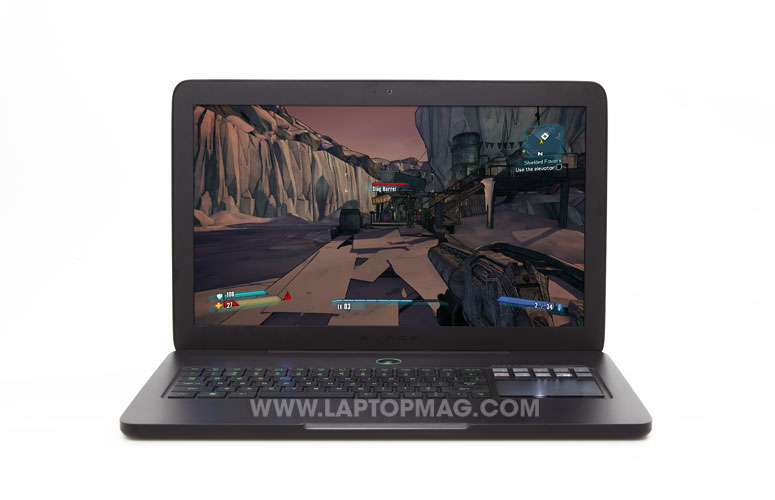
Click to EnlargeThe Razer Blade is one of the first laptops to feature Intel's new 2.2-GHz quad-core Core i7-3632QM CPU. Combined with its 8GB of RAM, the notebook effortlessly streamed the movie Drive on Netflix with 8 open tabs in Google Chrome, Mozilla Firefox and Internet Explorer while running a full system scan.
The notebook also held its own during our benchmark tests, notching 4,554 on PCMark 7. That's 902 points above the 3,652 desktop replacement category average. The Samsung Series 7 and its 2.3-GHz Intel Core i7-3610QM quad-core CPU only managed 3,611. The Alienware M17x R4 (2.6-GHz Core i7-3720QM CPU) was only slightly faster than the Razer at 4,610. However, the Origin Eon 17S took top billing with a score of 5,602, thanks to its 2.9-GHz Intel Core i7-3920XM processor.
Relying on a hybrid drive (500GB 7,200-rpm hard drive with 64GB SSD), the Blade booted the 64-bit version of Windows 7 Home Premium in 25 seconds. That was more than enough to smoke the 0:52 average as well as the Series 7 Gamer (dual 750GB 7,200-rpm hard drives) and the M17x R4's (500GB 7,200-rpm and 32GB SSD cache) times of 0:42 and 0:34. The Eon 17S (dual 120GB SSDs in RAID 0 configuration and 1TB 5,400-rpm hard drive) stopped the clock at a blistering 0:17.
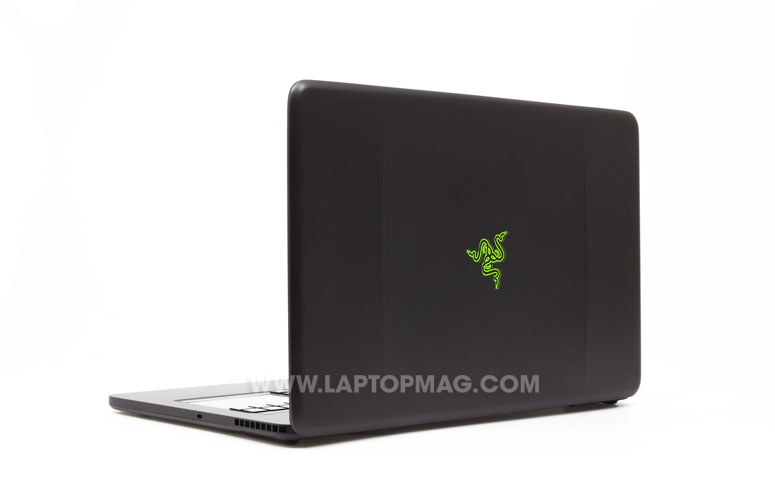
Click to EnlargeDuring the File Transfer Test, the Blade duplicated 4.97GB of mixed-media files in 59 seconds, a transfer rate of 86.3 MBps, comfortably above the 64MBps category average. The Series 7 Gamer and the M17x R4 scored 33 and 24 MBps. Only the Eon 17S scored higher with its whopping 254 MBps.
On the OpenOffice Spreadsheet Macrotest, the Blade paired 20,000 names to their matching addresses in 4 minutes and 34 seconds, slightly longer than the 4:22 category average. The M17x R4 completed the task in 4:10 while the Eon 17S continued to dominate with a time of 3:17.
Battery Life
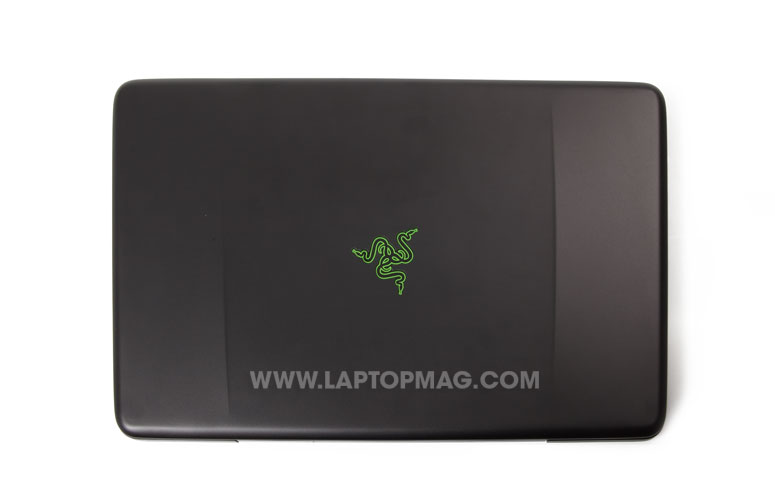
Click to EnlargeOn the LAPTOP Battery Test (continuous web surfing over Wi-Fi), the Razer lasted 3 hours ad 50 minutes. That's four minutes shy of the 3:54 category average. The Origin Eon 17s and Samsung Series 7 Gamer lasted 2:35 and 3:21 respectively. However, the Alienware M17x offered very good endurance with a runtime of 5:27.
Configurations
Our $2,499 review model of the Razer Blade features a 2.2-GHz quad-core Intel Core i7-3632QM CPU, 8GB of RAM, a 500GB 7,200-rpm hard drive with a 64GB SSD cache and a Nvidia GTX 660M GPU with 2GB of VRAM.
The original Blade is priced at $2,299 and has a 2.8-GHz Intel Core i7-2640 processor with 8GB of RAM, a 256GB SSD and Nvidia GT 555M processor with 2GB or VRAM. Razer is giving their early adopter customers a $500 discount on the new Blade, dropping the price to $1,999.
Verdict
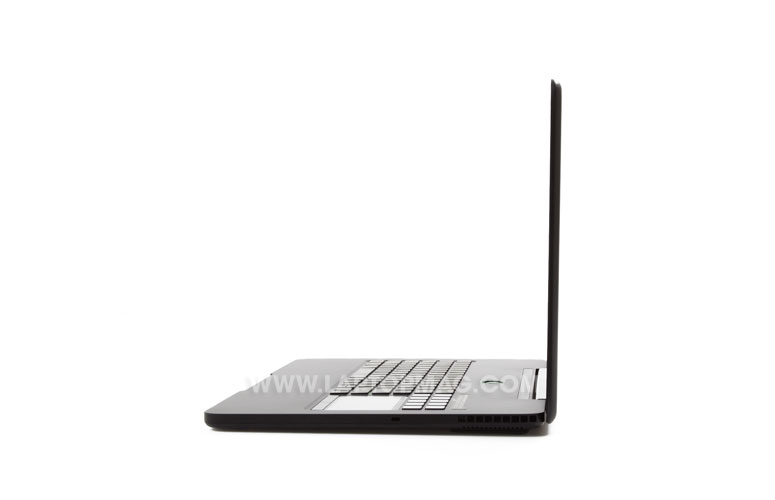
Click to EnlargeWe didn't think it could be done. But Razer has managed to create a highly portable 17.3-inch gaming notebook that delivers remarkable performance for its size. Getting the new quad-core Core i7 CPU and Nvidia GTX graphics in a sleek 0.88-inch shell is pretty sweet. And, there's no denying that its Switchblade UI is one of the most innovative things we've seen in a gaming notebook in a while. Just don't expect the same blistering frame rates you'd get from much beefier rigs.
That brings us to the real question gamers will need to answer: How much is mobility and a second screen worth? For the same $2,499 price of the Razer Blade, you can get an Alienware M17x with a Core i7-3610QM CPU, a 3D-enabled 1080p display, Nvidia GTX 680M graphics, and a 1TB hard drive in RAID 0. However, the M17x is more than 3 pounds heavier--not including its power brick. Bottom line: those looking for the most gaming muscle on the go will love this machine.
Razer Blade (2012) Specs
| Bluetooth | Bluetooth 4.0 |
| Brand | Razer |
| CPU | 2.2-GHz quad-core Intel Core i7-3632QM |
| Company Website | www.razerzone.com |
| Display Size | 17.3 |
| Graphics Card | Nvidia GeForce GTX 660M |
| Hard Drive Size | 500GB + 64GB SSD |
| Hard Drive Speed | 7,200rpm |
| Hard Drive Type | SATA Hard Drive + SSD |
| Native Resolution | 1920x1080 |
| Operating System | MS Windows 7 Home Premium (64-bit) |
| Optical Drive | None |
| Optical Drive Speed | n/a |
| Ports (excluding USB) | security lock slot, USB 3.0, Headphone, HDMI, Gigabit Ethernet |
| RAM | 8GB |
| Size | 16.81 x 10.9 x 0.88 inches |
| Touchpad Size | 3.5 x 2.3 inches |
| USB Ports | 3 |
| Video Memory | 2GB |
| Warranty/Support | Standard 1 year warramty |
| Weight | 6.6 pounds |
| Wi-Fi | 802.11a/g/n |

Sherri L. Smith has been cranking out product reviews for Laptopmag.com since 2011. In that time, she's reviewed more than her share of laptops, tablets, smartphones and everything in between. The resident gamer and audio junkie, Sherri was previously a managing editor for Black Web 2.0 and contributed to BET.Com and Popgadget.
